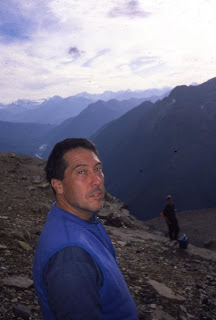Anugata
 Of all of the extraordinary individuals that I've known -- in and out of the Center -- I'm not sure any of them compare with Anugata. I'm sorry that, at least early on, I was not a better friend to him.
Of all of the extraordinary individuals that I've known -- in and out of the Center -- I'm not sure any of them compare with Anugata. I'm sorry that, at least early on, I was not a better friend to him.In times future, I imagine that some people will look back and marvel at Anugata's impressive physical achievements. As a youth, he was a tennis champ. In the Center, he ran countless marathons and ultra events (including running across the Sahara). He swam the English Channel. And now he's got Mt. Everest in his sights. (Great photo of Anugata in the Himalayan foothills from one of Jowan's galleries.)
In my imagination, however, I see Anugata standing naked before a mirror. Looking at himself, he repeats the mantra of the ancient jnana yogis: "Not this, not this." To me, Anugata has always seemed a sage.
My earliest memory of Anugata is as a storyteller. He told great stories from the Mahabharata and the other epics of Indian mythology. There was a British disciple who would often be asked to sit in front of the disciple audience at Progress-Promise during Celebrations to give his rendition of the classic stories. He was a master of detail, but I preferred Anugata's tellings. Anugata is a knower, not just a teller.
My own pet theory is that some of the strong individuals that I have been blessed to know have, in the hoary past, been men of considerable inner achievement. When I think of Anugata, I am reminded of Tota Puri. (I guess I shouldn't be shocked that Tota Puri has his own Wiki page here.)
Tota Puri -- or the "Naked One" as Sri Ramakrishna called him -- was a wandering sadhu from the northern provinces of India. He had been raised in a monastery and rose to become its abbot before he dropped all for the wandering life. He walked the countryside naked, with only a walking stick, a bowl, and a pair of tongs. He never spent more than three days in any one place.
Arriving at the Kali Ghat -- where a young Ramakrishna was in residence as the temple priest -- Tota Puri noticed the young priest amongst the morning crowd at the Ganges. "You have the look of a knower of Brahman," Tota Puri remarked. "Would you like to learn about the Vedanta?"
Ramakrishna said that he'd have to ask his Mother. "Yes, go and ask your mother," the naked sadhu replied (one imagines a bit contemptuously). Perhaps needless to write, Ramakrishna wasn't referring to his human mother.
With the inner permission obtained, Tota Puri initiated Ramakrishna into the worship (for lack of a better word) of the formless Absolute. Ramakrishna's quick progress, to say the least, shook Tota Puri to his roots and he broke his wandering habit and remained at Dakshineswar with Ramakrishna for six months. By the time he resumed his wanderings, he too had realized that nothing is done without the permission of the Mother.
How would someone like Tota Puri cope in today's world? The conventional answer, perhaps, would be that he wouldn't -- a great soul like that would never incarnate again after having achieved liberation. I don't think it works that way though.
My sense is that these "great souls" (I think they would shudder at this label) are not conventional. The very qualities that made liberation possible -- heroic independence, fearlessness, the courage to seek -- rather than avoid -- a challenge, would almost demand their continued action in the world. Were Tota Puri to appear in the modern world, I suspect he'd look very much like Anugata.
The heights of immobile trance having been scaled, the great soul attempts to establish its influence over the physical world, the world of action. The soul takes up the new challenge of what Sri Aurobindo calls the "Live Divine."



Comments